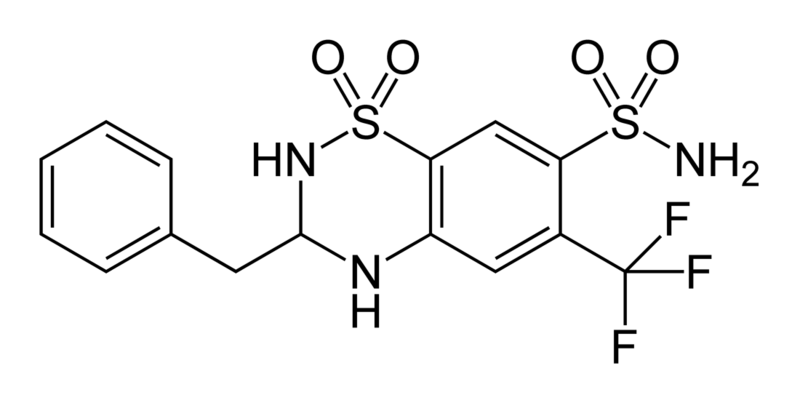Thiazide



Editor-In-Chief: C. Michael Gibson, M.S., M.D. [1]
Thiazide is a term used to describe a type of molecule[1] and a class of diuretic.[2]
The members of these diuretics are derived from benzothiadiazine. They inhibit Na+/Cl- reabsorption from the distal convoluted tubules in the kidneys by blocking the thiazide-sensitive Na+-Cl- symporter. Thiazides also cause loss of potassium and an increase in serum uric acid. The chemical structure of the original thiazide diuretics contained a thiazide ring system; the term is also used for drugs with a similar action that are not chemically thiazides, such as chlortalidone and metolazone.
Denomination
That thiazide both refers to the type of molecule and the medication can sometimes lead to confusion, because some molecules can be considered thiazide diuretics, although they are not thiazides from a chemical perspective. In this context, "thiazide" refers to a drug which acts at a "thiazide receptor"[3], which is believed to be a sodium-chloride symporter.
Primary uses
Because of their vasodilator properties, Thiazides are often used to treat hypertension. They are the recommended first-line treatment in the US (JNC VII)[4] guidelines and a recommended treatment in the European (ESC/ESH)[5] guidelines. They have been shown to prevent hypertension-related morbidity and mortality although the mechanism is not fully understood. Thiazides cause vasodilation by desensitizing the vascular smooth muscle cells to calcium release induced by norepinephrine.[6]
Among the thiazides and thiazide-like diurectics, chlorthalidone may be more effective for hypertension control than hydrochlorothiazide.[7]
Side effects
Side effects can include hypokalemia, increased serum cholesterol, and impotence. The side effect of hypokalemia has motivated combining thiazides with potassium sparing diuretics (eg with amiloride in co-amilozide) and with the newer ACE inhibitors, which also lower blood pressure but cause hyperkalemia as a side effect.
Long-term usage of thiazides is also linked to increased levels of homocysteine, a toxic amino acid byproduct, that has been associated with atherosclerosis. It is recommended that patients receiving long-term thiazide treatments also receive folic acid supplements to combat the risk. They have been known to cause a paradoxical effect in Diabetes insipidus, where they reduce the volume of urine. Thiazide diuretics are capable of inhibiting urate secretions.
About 3% of the population will have an allergic reaction to a thiazide. Signs and symptoms of an allergic reaction include a rash(either eczematous reaction with red itchy scaly skin and crusting or erythema anular centrifugum), hives, itching, nasal congestion, shortness of breath, wheezing, tachycardia, cough, nausea or diarrhea. Anaphylactic reactions with hypotension, angioedema and a leukocytoclastic vasculitis are rare.
Other uses
Thiazides also lower urinary calcium excretion, making them useful in preventing calcium-containing kidney stones. This effect is associated with positive calcium balance and is associated with an increase in bone mineral density and reductions in fracture rates attributable to osteoporosis. Because of those properties, they are also used in the treatment of Dent's Disease or idiopathic hypercalciuria.
Thiazide may be combined with ACE inhibitors to increase diuresis without changing plasma potassium concentrations. While ACE inhibitors cause diuresis with potassium retention, thiazide increases potassium excretion. Their combined effects on potassium cancel each other out.
Breast milk
It should be noted that thiazides pass through breast milk, and in some cases, decrease the flow of breast milk. There is no specific information regarding the use of thiazides in children, but it is still advised that mothers avoid using thiazides during the first month of breast feeding.
Mechanisms of hypokalemia
There are several mechanisms by which thiazide diuretics cause hypokalaemia (decreased plasma potassium concentration):
- Increased delivery of sodium to the collecting ducts causes the Na/K exchanger to be activated resulting in K (and H+) loss.
- Activation of renin-angiotensin-aldosterone system by the diuretic hypovolaemia: body responds to hypovolaemia by opposing diuresis, one effect of which is to produce aldosterone which stimulates the Na/K exchanger, resulting in further loss of potassium. For this reason, ACE inhibitors, which inhibit angiotensin II production and therefore aldosterone activation, are frequently used in combination with thiazides to combat hypokalaemia.
- Flow rate in nephron is increased under diuresis, reducing potassium concentration in the lumen, thus increasing the potassium gradient. Potassium loss through the many potassium channels, such as ROMK. These are not exchangers; they allow facilitated diffusion, so the increased gradient is directly responsible for increased diffusion.
References
Moreno, E (2006). Affinity-defining Domains in the Na-Cl Cotransporter. J. Biol. Chem. 281, 17266-17275.
- ↑ Thiazides at the US National Library of Medicine Medical Subject Headings (MeSH)
- ↑ Thiazide+Diuretics at the US National Library of Medicine Medical Subject Headings (MeSH)
- ↑ thiazide+receptor at the US National Library of Medicine Medical Subject Headings (MeSH)
- ↑ "The Seventh Report of the Joint National Committee on Prevention, Detection, Evaluation, and Treatment of High Blood Pressure (JNC 7)".
- ↑ "escardio.org".
- ↑ Zhu Z, Zhu S, Liu D, Cao T, Wang L, Tepel M (2005). "Thiazide-like diuretics attenuate agonist-induced vasoconstriction by calcium desensitization linked to Rho kinase". Hypertension. 45 (2): 233–9. doi:10.1161/01.HYP.0000152701.97426.5f. PMID 15611360.
- ↑ Bakris GL, Sica D, White WB, Cushman WC, Weber MA, Handley A; et al. (2012). "Antihypertensive Efficacy of Hydrochlorothiazide vs Chlorthalidone Combined with Azilsartan Medoxomil". Am J Med. 125 (12): 1229.e1–1229.e10. doi:10.1016/j.amjmed.2012.05.023. PMID 22939358.
External links